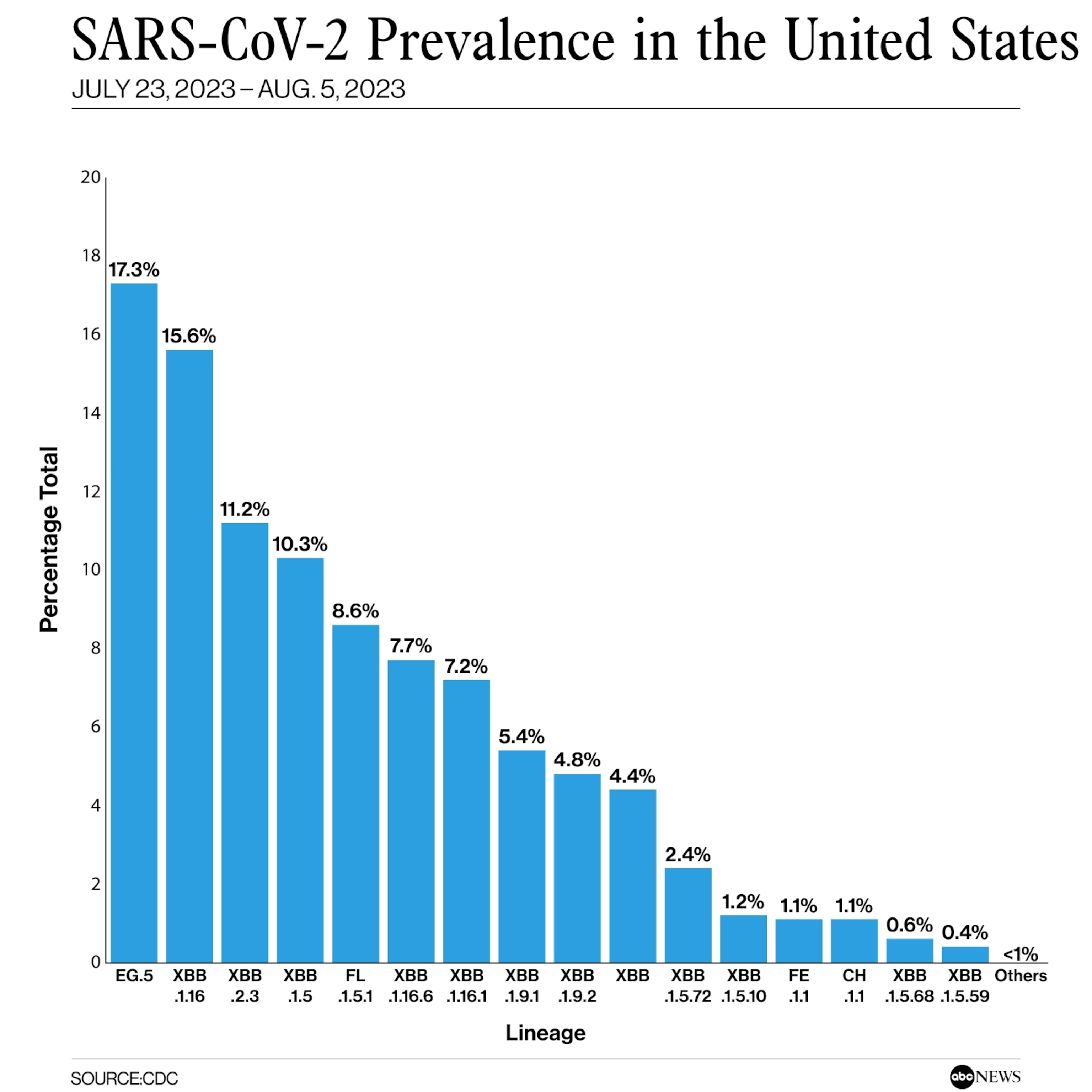EG.5 now dominant COVID variant in US. Here's what to know
CDC data shows EG.5 makes up an estimated 17.3% of cases.
A new variant now makes up a plurality of COVID-19 cases in the United States, federal data shows.
EG.5, an offshoot of the omicron variant and descendant of the XBB strain, has been circulating in the country since at least April. However, as of Aug. 5, it accounts for 17.3% of COVID infections, according to the Centers for Disease Control and Prevention.
This is an increase from the 1.1% of cases it was estimated to make up at the end of May, CDC data shows.
It comes as COVID hospitalizations tick up across the U.S., increasing 12.5% in the most recent week to a total of 9,056 hospitalizations, according to the federal health agency.
Meanwhile, in the United Kingdom, EG.5.1, which falls under the EG.5 lineage, makes up an estimated 14.55% of cases, making it the second most common strain, according to the UK Health Security Agency.

Public health experts said there is no evidence EG.5 causes more severe illness and that it's normal for the virus to mutate and new variants to emerge.
"Omicron is out there making minor variations. It's having children, progeny, but they're all closely related to omicron," Dr. William Schaffner, a professor of preventive medicine and infectious diseases at Vanderbilt University Medical Center, told ABC News. "They are contagious, but they are not more serious, so that's excellent."
The uptick in hospitalizations could be due to a mix of factors, including some waning immunity and people starting to gather indoors. But experts said the numbers are still among the lowest seen since the pandemic began.
"If you take a low number and you talk about it in terms of percent increase, it's going to sound a lot scarier than it is, right?" Dr. Shira Doron, chief infection control officer for Tufts Medicine, told ABC News. "So, in an extreme circumstance, if there was one COVID case in the world and then there were two, that would be 100% increase, which sounds really bad, but two is a pretty low number."
"We are going to see some uptick in cases because that new variant replaces the old one … and so what we see is a small uptick, but we're still at the lowest levels we've ever seen," she continued.
As of July 19, the World Health Organization listed EG.5 as a variant under monitoring, but experts said it should not be considered worrisome but rather a sign of good surveillance.
"Having this surveillance system for strains of COVID out there around the world is a way for us to be on the alert should a new distinctly different mutation suddenly appear and start to spread in any country, not just in the U.S.," Schaffner said. "We would get advance notice and we could start to prepare for that."
Experts said unless there is evidence EG.5 or its sublineages are causing more severe disease, the guidance previously recommended by public health officials is still the same, including assessing your own risk tolerance, remaining vigilant and staying up to date on vaccinations.

The CDC is expected to issue recommendations soon about a new COVID booster, just in time for fall, when COVID cases and hospitalizations typically increase.
"The booster coming in the fall is based on XBB, and that was a gamble and that will always be a gamble because the strain is selected in June and you can't know for sure what strain is going to be predominant in the fall when it's June," Doron said. "So, the booster will be an XBB monovalent booster, but that's okay. The vaccines still work even when they're not completely matched to the circulating strain."



